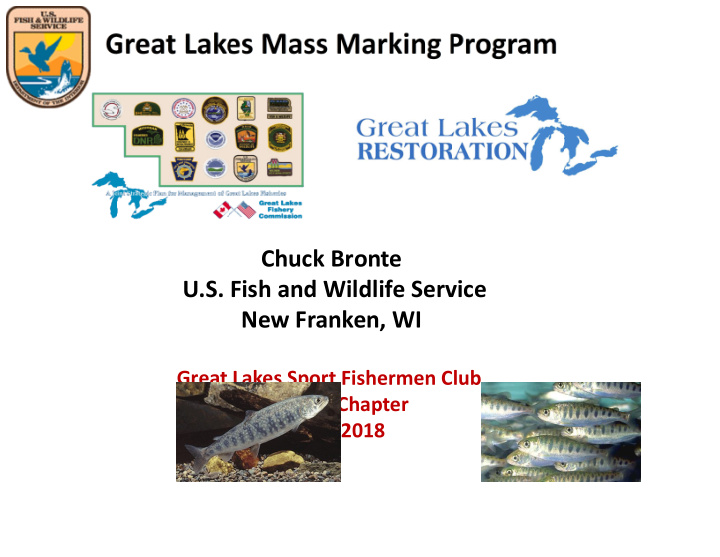



Chuck Bronte U.S. Fish and Wildlife Service New Franken, WI Great Lakes Sport Fishermen Club Ozaukee Chapter Nov 6, 2018
Outline Updates from the Great Lakes Mass Marking Program - Program overview - Chinook salmon results - Lake trout results
The Great Lakes Mass Marking Program • A collaboration among federal, state, and tribal agencies coordinated by the U.S. Fish and Wildlife Service • Established to help address questions and management objectives for salmon and trout fisheries • Provides tagging, marking, field data collection, and analytical support services for Great Lakes fisheries management
Tagging and Marking Operation • Mass marking – lake trout began in 2010, Chinook salmon in 2011, Steelhead in 2017 • About 10 million fish tagged/year; over 80 million fish since 2010 • Tags lots identify fish to stocking location, year class, and genetic strain
Tag Extraction and Reading Operation • Over 100,000 snouts have been processed, with more than 86,000 CWTs recovered through 2017 Thanks to your support we have 7 years of data on over 130,000 fish from open-water angling.
2018 – 2019 GLRI Funding Outlook Funding Millions Tagged and Fish Year Millions $ Source Use or marked sampled 1.50 GLRI – FHU Template Operations/ same as FY 18 2019 analysis 0.50 GLRI – FHU Template Operations/ same as FY17 2018 1.00 GLRI – carryover analysis 0.69 GLRI – FHU Template Operations/ 1.9 Chinook salmon 10,474 0.60 GLRI – carryover FY17 analysis 3.8 lake trout 2017 2.8 steelhead/RBT 0.85 GLRI – FHU Template Operations/ 22,154 2.8 Chinook salmon 2016 0.48 GLRI – LAT/LAS Template analysis 4.9 lake trout 1.00 GLRI – FHU Template Operations/ 21,189 2.9 Chinook salmon 2015 0.44 GLRI – LAT/LAS Template analysis 6.4 lake trout Operations/ 21,778 2.9 Chinook salmon 2014 1.50 GLRI – FHU Template analysis 6.4 lake trout GLRI – Fish Habitat Utilization Operations/ 16,879 2.9 Chinook salmon 2013 1.50 Template analysis 5.7 lake trout Operations/ 11,712 4.3 Chinook salmon 2012 1.50 GLRI – FHU Template analysis 6.1 lake trout 4.7 Chinook salmon 2011 1.50 GLRI – FHU Template Operations 5.8 lake trout Congress and GLRI through 3.60 Great Lakes Fish and Wildlife Equipment/ 2010 1.1 Chinook salmon Restoration Act operations 4.6 lake trout 1.50 Congress Equipment 2009 1.73 Congress Equipment 2008
Great Lakes Mass Marking Program Act Introduced by Stabenow, Debbie [D-MI]; June 2017; Cosponsors: Peters, Gary C. [D-MI], Brown, Sherrod [D-OH], Schumer, Charles E. [D-NY] • formally establishes the program in the FWS • specifies collaboration with states, tribes and other federal agencies • make all data available to applicable agencies • authorization of $5.0 million annually during 2018-2022 .
Chinook Salmon Wild Recruitment • “Stocked” fish have AD clip only or a AD clip with CWT • “Wild” fish have no clip or CWT • Only ~0.5% of stocked fish are not clipped due to error • Little fin regeneration; 99.5% unclipped fish are wild
Chinook Salmon Wild Recruitment Most Chinook salmon in Lakes Michigan and Huron are wild Wild recruitment is variable and needs to be monitored annually
Chinook Salmon Survival High survival of Wisconsin-stocked Chinook salmon Wisconsin Lake Huron Michigan Indiana Illinois
Chinook Salmon Survival • Favorable temperatures • More alewives • Rocky shoreline for invertebrates • Predation in Green Bay
Chinook Salmon Survival Fish stocked on the western shore survive the best Poor survival for fish stocked in Green Bay and MM6
Percent of Chinook Captured in Stocking District Chinook Salmon Movement 2011 Year Class
Chinook Salmon Movement Lakewide movement during summer Summer capture location not likely to be stocking location Fall fishery determined by stocking location
Chinook Salmon Growth – Stocked Fish N = 16,493 Total Length (mm) Stocking Region Age (years)
Chinook Salmon Growth Growth Survival • Growth may lead to good survival • May relate to food or temp differences
Chinook Salmon Growth Growth similar among locations Growth and survival seem to be related Stocked fish grow faster than wild fish Annual variability in growth linked to annual abundance of alewife – not expected if alewife were not limited
Lake Trout Wild Recruitment • Percent of wild fish 65% up 3 – 19 % from 13% last year 51% 14% 0% • Population is not 80% rehabilitated, but 22% 10% progress is positive 25% 28% 24% 31% 28% Lake Trout 32%
• Greater returns per fish stocked from offshore • 62% of stocked lake trout in angler creels are from offshore locations • Higher survival offshore may offset need to move nearshore
Lake Trout Results Numbers of wild lake trout appear to be increasing Lake trout stocked offshore contribute the most to nearshore sport catch
Thank you for your attention and support Contact Matt: charles_bronte@fws.gov Phone 920.866.1761 Acknowledgements Hatcheries staff Lake Committees Bio-Technicians Lake Trout and Salmonid Working Groups Creel Clerks Anglers
Recommend
More recommend